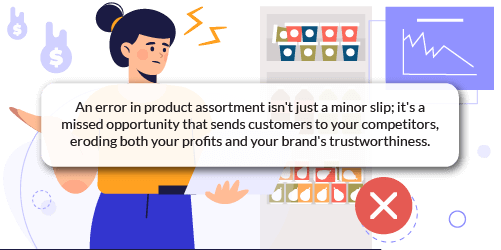In small retail spaces, every square foot and every item is critical, leaving little room for error. A single misstep in your product assortment - and assortment planning - can quickly escalate into a series of setbacks, harming your brand and customer trust. Mastering this intricate maze isn't only about avoiding pitfalls. It's about skillfully balancing customer expectations with the harsh realities of running a small business.

Why does your retail assortment matter so much? Because it's not just about the products you offer. The right product assortment builds brand loyalty, fuels repeat business, and turns casual shoppers into devoted fans. Get it wrong, and you're not just facing excess stock or empty shelves—you're risking the very future of your business.
So, how can you ensure your retail assortment strategies hit the mark? It starts with avoiding common pitfalls that even seasoned retailers fall into. From overstocking to ignoring local preferences, these errors can quietly erode your profits and customer goodwill. Knowing what not to do is the first step in crafting an assortment that sells and turns first-time visitors into lifelong customers.

It's a mistake if you have a lack of product variety
A lack of variety can quickly send potential customers to your competitors.
Offering a balanced variety of products is not just a nicety but a necessity that can significantly affect customer engagement, sales, and overall brand image. Customers appreciate choices but also want those choices to be curated and relevant. A well-thought-out variety adds value to the shopping experience and is critical in retail assortment strategies.
Limited variety can impact sales. Consider the famous example of Blockbuster versus Netflix. While Blockbuster offered a variety of movie titles, the assortment paled in comparison to Netflix's extensive catalog that caters to an array of tastes and preferences.
According to statistics, Netflix garnered over 208 million paid subscribers worldwide as of 2021, while Blockbuster had to close shop. Limited variety played a role in one rising and the other falling.
Similarly, supermarkets that focus on assortment planning by offering a wider variety of organic or locally sourced goods can expect an increase in overall sales compared to those without a diverse product assortment. Limited variety means not just missing out on sales but also losing customers who find the retail assortment they desire elsewhere.
So, how can small retailers optimize their product assortment without compromising quality or focus? Here are some actionable tips:
- Customer feedback: Always listen to what your customers are saying. They are your best source of information about what variety they want to see.
- Market research: Study your competitors and see what they are offering. Identify gaps in the market that you can fill.
- Pilot testing: Before going all in, try offering new products on a smaller scale to gauge customer interest.
- Quality control: Expanding variety doesn't mean lowering your standards. Never compromise on quality. Instead, work with trusted suppliers or producers.
- Regular reviews: Regularly review your sales data to understand which products are performing well and which aren't. Adjust your variety accordingly.
By offering a balanced, curated variety of products, you attract more customers and enhance their shopping experience, making them more likely to return.

It's a mistake to overstock unpopular products
Inventory is a double-edged sword in retail assortment planning. While adequate stock ensures you meet customer demand, overstocking can quickly turn into a financial nightmare.
The repercussions of poor product assortment planning are far-reaching, from increased holding costs such as warehouse fees, utilities, and labor to the depreciation of goods over time. When items sit on the shelf for too long, they may become outdated or spoiled, forcing you to mark them down significantly to move them out. This vicious cycle not only drains financial resources but also diminishes the perceived value of your brand.
The most immediate financial impact of overstocking in your retail assortment is an increase in holding costs. These are the expenses associated with storing unsold goods. Furthermore, overstocked items often require forced markdowns or promotions to accelerate sales. These eat into your profit margins and devalue your brand.
The solution lies in smart assortment planning, which includes intelligent inventory management and more accurate demand forecasting. To prevent overstocking, here are some actionable steps you can take:
- Lean inventory principles: If a full Just-in-Time system feels overwhelming, consider adopting lean inventory principles tailored for small businesses. Focus on keeping only enough stock to meet short-term demand and build strong relationships with local suppliers for quicker restocks when needed.
- Use technology: Leverage inventory management software to track sales trends and predict future demands. These tools often have advanced analytics that alert you when your stock levels and sales projections aren't aligned.
- Regular audits: Conduct frequent physical counts to cross-verify with what's in your system. Any discrepancies can be early indicators of problems like overstocking or understocking.
- Supplier relationships: Maintain good relationships with suppliers. Flexible and understanding suppliers can help you adjust orders more quickly, reducing the risk of overstocking.
- Seasonal forecasting: If your business is seasonal, tailor your inventory to meet specific demands. Overlooking seasonality can result in significant overstock.
By actively managing your inventory and improving your forecasting methods, you can steer clear of the pitfalls of overstocking. Adopting a data-driven approach safeguards your bottom line and ensures your customers find what they need when they need it, further strengthening your brand's reputation.

It's a mistake to understock popular items
The flip side of overstocking in retail assortment planning is understocking, particularly of popular items. Understocking these key elements of your product assortment can sabotage your sales and erode customer trust just as much as overstocking can. Understocking leads to stock-outs, and when customers encounter out-of-stock messages or empty shelves, their first instinct is often to turn elsewhere. It results in lost immediate sales and affects customer satisfaction and loyalty in the long run.
Stock-outs can negatively impact your brand's reputation and your retail assortment strategies.. Today's consumers have options at their fingertips, and they won't hesitate to switch to a competitor if they consistently find gaps in your product assortment.. It can create a ripple effect: dissatisfied customers are more likely to share their poor experience, whether it's through word-of-mouth or online reviews, which can deter potential new customers.
To avoid understocking, you must master the art of assortment planning, which includes precise inventory tracking and accurate demand prediction. Here are some actionable tips to help you do just that:
- Historical data analysis: Use past sales data to identify trends, best-selling items, and peak shopping periods. We recommend reviewing your sales data at least once a month to understand which items are in high demand. You can use tools like Excel spreadsheets to track this data if advanced analytics software is out of budget.
- Real-time inventory tracking: Utilize technology that offers real-time inventory tracking. If a real-time system is not feasible, maintain a simple spreadsheet to keep tabs on your inventory levels. Make it a practice to update this daily, or multiple times a day during busy periods.
- Safety stock: Always maintain a 'safety stock' level for best-selling items. It's a small, additional quantity of an item kept on hand to reduce the risk of a stock-out.
- Supplier communication: Maintain open lines of communication with your suppliers. If they know your needs, they can often expedite orders when you're running low on popular items.
- Customer feedback: Don't underestimate the power of listening to your customers. If multiple people ask for the same product, it's a clear sign that you need to stock it.
By efficiently managing your product assortment and honing your demand prediction capabilities, you're not just avoiding stock-outs; you're optimizing your retail assortment strategies. You're enhancing the customer experience. This creates a win-win situation, enhancing customer satisfaction and boosting sales, thereby strengthening your brand's reputation and the effectiveness of your retail assortment strategies.

It's a mistake to ignore local preferences
Understanding and catering to local preferences is paramount to your success in retail assortment planning, as overlooking them could lead to missed opportunities and decreased sales in your product assortment.
Multiple factors shape local preferences, from the culture and history that influence local festivals and traditions to the climate, which can dictate seasonal clothing choices and even socioeconomic conditions that determine purchasing power.
Ignoring these can result in stocking items that, while popular elsewhere, might find few takers in a specific region. On the other hand, incorporating local tastes into your assortment can create a connection with your customers, positioning you as not just a store but part of the community.
For small retailers like you, with limited shelf space, every product choice in your retail assortment becomes crucial. It's essential to stock items in your product assortment that will surely appeal to local customers. With this in mind, here are actionable tips to ensure your product assortment resonates with local preferences:
- Engage with your customers: Start conversations in person and on social media to understand their needs and preferences. Feedback forms or suggestion boxes can also be valuable tools.
- Local supplier partnerships: Form partnerships with local suppliers and artisans. That ensures products resonate with local tastes and adds a unique flair to your store that big-box retailers might lack.
- Attend community events: Participate in or attend local fairs, markets, or festivals. These events offer insights into the community's culture and preferences.
- Analyze sales data: Regularly review those products that are selling well and those that aren't as well as you'd hoped. That provides clear insights into the preferences of your customer base.
- Run limited-time offers: Test new products that cater to local tastes by offering them for a limited period. Gauge their popularity before deciding to stock them regularly.
By consciously localizing your product assortment, you're demonstrating an understanding and valuation of what your local shoppers want, thereby optimizing your retail assortment strategies. In return, they are more likely to trust you and become loyal.

It's a mistake to disregard your retail data
Making decisions based on intuition in retail assortment planning is akin to navigating a ship without a compass. While instinct and experience have their place, relying solely on them can lead to avoidable consequences.
Intuition doesn't always consider the broader picture or the minute intricacies of retail. For instance, while a product might seem popular because people frequently discuss it, it might not necessarily translate to sales. Similarly, introducing a product based on a gut feeling without understanding its market demand can lead to overstocking and subsequent losses.
In contrast, data-driven decisions provide a more holistic, factual, and reliable basis for action. Here are some guidelines to leverage your data effectively:
- Collect sales data regularly: Invest in a point-of-sale system, even a basic one, that can record and store daily sales. This data can help identify which products are in demand, which are out of favor, and what times of the year see peak sales.
- Seek continuous customer feedback: Utilize feedback forms, suggestion boxes, or even quick verbal check-ins with customers. Understanding their needs, preferences, and dissatisfaction areas can guide inventory decisions.
- Monitor market trends: Stay updated with industry news, attend trade fairs, or join local business associations. These can provide insights into emerging trends, helping you to stay ahead of the curve.
- Analyze the data: It's not just about collecting data but making sense of it. Use tools like Excel to create charts or graphs, or consider user-friendly retail analytics software tailored for small businesses. Periodic reviews can highlight patterns and guide strategic decisions.
By shifting towards data-driven decision-making, small retailers can reduce the uncertainty that often comes with intuition-based choices. In an industry where precision can lead to profitability, it's imperative to harness the power of data to make informed, effective decisions.
Conclusion
Effective product assortment planning is the cornerstone of thriving retail businesses and is integral to successful retail assortment strategies. As you've read, getting it wrong can be costly. By anticipating potential pitfalls in your product assortment and retail assortment planning, you're already a step ahead. For more invaluable insights and proven strategies in retail assortment, subscribe to our newsletter today.


